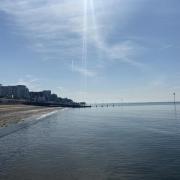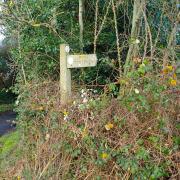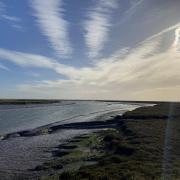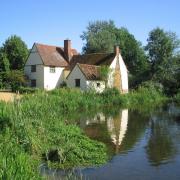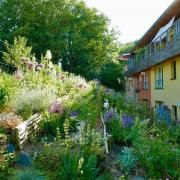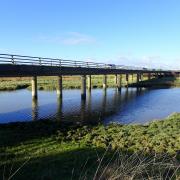By Andrew Millham
So much of Essex feels undiscovered; miles of coastline, historic towns and idyllic landscapes are brimming with cool and quirky days out for the whole family. Andrew Millham goes on the hunt for the best gems just waiting to be uncovered...

1. Land of the Fanns
The Land of the Fanns is an ancient, marshy and low-lying landscape, which spreads across East London and South West Essex, from Basildon to Rainham and from Brentwood down to the Thames. Historically used for farming and forestry, urban sprawl and industrial development has eaten much of the rural lands that border the Thames. However, some patches are largely unchanged.
It all began at Langdon Hills in 1768, when Essex historian Philip Morant looked upon the green panoramic views calling it the ‘grandest prospect in England.’ Much later, in 1857, Leslie Thompson coined the name The Land of the Fanns because the view from Langdon really does fan out before your eyes.
Today, Land of the Fanns is a scheme that collaborates with various organisations to deliver environmental projects and to protect 15 heritage sites, including Rainham Hall, Coalhouse Fort Park and Upminster Windmill.
Website: landofthefanns.org

2. Hadleigh Castle
Hadleigh Castle is right on my doorstep, and it still leaves me in awe. Set high upon a hill, looking down over marshes and the Benfleet Estuary, building of the castle began in the 1230s by Hubert de Burgh, Earl of Kent, after he was gifted the land by King John, for whom he was chief minister and justiciar.
It was extensively refortified by Edward III during the Hundred Years War because, strategically, it was perfectly situated for defending the Thames from French raids. It eventually became a favourite retreat for the ageing king – I can see why.
The views from this romantic ruin are spectacular, from sunrise to sunset, and upon close inspection, the checkerboard flint work on the walls shows the amount of effort that went into its design, truly fit for royalty. Managed by English Heritage, it’s free to enter, with beautiful walks into Hadleigh Country Park and Old Leigh.
Address: Castle Lane, Hadleigh SS7 2AP
Website: english-heritage.org.uk

3. Leigh-on-Sea Brewery
Tucked away in a small corner of Leigh-on-Sea is a cosy brewery and taproom making and serving award-winning ales and craft beers. Founded in 2017, Leigh-on-Sea Brewery currently welcomes visitors to its taproom on Thursdays, Fridays and Saturdays to sit, relax and purchase freshly made food to accompany a beer. It is an intimate and contemporary setting, whilst upholding all that is grand about traditional ales.
I first tasted its beers a few years ago at the annual fair on the John Burrows fields in Hadleigh, and I was so pleased to see a local brewery supporting local events. The various drinks have names like Two Tree Island, SS9 and Pier Train, reminding the drinker of exactly where they came from.
Address: 35 Progress Road, Leigh-on-Sea SS9 5PR
Website: leighonseabrewery.co.uk

4. Paycocke’s House and Garden, Coggeshall
This grand, timber-framed house was built around 1500 for Thomas Paycocke, a wealthy Tudor merchant who made his fortune in East Anglia in the cloth trade. The quaint beamed rooms are filled with amazing furniture, the wood around the fireplace is stunningly carved (including with his name), and the walls elaborately panelled – they have more than a few stories to tell. Not only that, the house also has a colourful cottage garden, which is tended by green-fingered volunteers.
Today, the site is lovingly looked after by the National Trust, and it is just about to reopen after closing for the winter. Whether you are a lover of history, the Arts and Crafts movement or simply a fan of unique days out – Paycocke’s is not to be missed.
Address: 25 West Street, Coggeshall, Colchester CO6 1NS
Website: nationaltrust.org.uk

5. Discovery Seal Trips, Wallasea
Did you know you can see a seal up close in Essex? Discovery Charters run seal trips from Essex Marina on Wallasea Island and Burnham Town Quay. Day-trippers go on an exploration of the silty creeks of Foulness and Potton Island in search of the common seals. The seals are filled with intrigue, coming close to the boat, curious as to who is encroaching on their watery domain.
Seals are not the only wildlife that can be expected on the tour, but also oystercatchers, little egrets, common terns carrying silvery fish back to nesting sites and – if you are very lucky – marsh harriers. Even if you do not have the soundest sea legs, this is truly an Essex gem.

6. Battlesbridge Antiques Centre
I have visited Battlesbridge since I was young, and for me it has always been steeped in mystery. The dark wooden granary building on the banks of the River Crouch is filled with treasures that you could spend months sifting through. I will never forget finding a small model of a cream-coloured Triumph Spitfire, my dad’s favourite car, and buying it for his birthday. The centre is host to more than 80 friendly and knowledgeable antique dealers.
Right at the top on the fourth floor is a family run business called The Hideaway Tearoom, a regular haunt of mine, where the views (and the cakes) are incredible. This is an all-round great day out!
Address: 5 Maltings Road, Battlesbridge, Wickford SS11 7RF
Website: battlesbridge.com
7. Heights of Essex – Chrishall Common
Essex is one of the flattest counties in Britain, so it makes a great change to go in search of the highest point. Right on the border with Cambridgeshire and Hertfordshire, Chrishall Common is officially the ‘county top’ of Essex, at 482 ft above sea level. There are far-reaching views over the grasslands and road construction has avoided this high ground, so it remains beautifully off-the-beaten-track. The town itself has retained a sense of isolation, which is hard to find this close to London, with a population of around 450 people. Many websites provide brilliant walking routes to follow for visitors and furry companions.

8. Prettyfields Vineyard, Ardleigh
While lots of tourists visit Colchester, not many will venture just outside the town to visit some of the area’s incredible local producers. Prettyfields Vineyard is nestled in timeless Essex countryside and provides a wonderful base for idyllic walks, and of course, tasting wine. The small team run tours of the vineyard, allowing guests to peek behind the curtain of the wine-making process. England has a great climate for wine production, and English wine is rapidly gaining recognition on the international stage – it is lovely to see a local vineyard leading the charge.
Address: Dead Lane, Ardleigh, Colchester CO7 7PF
Website: prettyfields.com

9. Heybridge Basin
Maldon is well-known to most Essex-dwellers, but Heybridge Basin is slightly more obscure. The village is centred around a huge sea lock at the end of the 13-mile Chelmer and Blackwater Navigation, which joins the canal to the Blackwater Estuary. The basin was dug out of the marsh to enable sea-going vessels to unload cargo bound for Chelmsford. Today, it is a haven for leisure craft. From the sea wall, you can enjoy views over the estuary and Osea Island – you may even see a historic Thames barge cruising out of Maldon – and all this can be made even better with a bowl of chips.
Heybridge Basin retains a sense of maritime authenticity. Looking over peeling paint on windowsills into shipwright’s workshops, it feels like a centuries-old nautical tradition is being lovingly upheld.
Website: visitmaldon.co.uk

10. Riverview Café at Hullbridge
There are so many amazing places in Hullbridge, but this is a favourite of mine. Parking in the centre of the town, it is a great pleasure to amble down to the silty shore to feed the swans, which usually descends into throwing bread in the air to watch the swarming seagulls catch crumbs on the wing.
Making a right, I walk along the narrow-hedged paths, past the playing fields, all the way to a little café by the sailing club called Riverview. Without wishing to make this sound like a review, the owner could not try harder with customer service. It is spotless and he sits us next to an electric heater on particularly cold days! In summer, it is wonderful to rest on the benches and enjoy the views of sailing boats and the glinting River Crouch.
Address: Club House, Pooles Lane, Hullbridge, Hockley SS5 6PZ
Website: facebook.com/riverviewhullbridge

11. Boydells Dairy Farm
This small working farm specialising in sheep milking is run by the Threadgold family, who offer guided tours with plenty of opportunities to get hands-on! You can try milking a cow, feeding hens, collecting eggs, rising a donkey cart or, as they put it, ‘outstaring a llama’. The chief part of your visit will surely be sheep milking – they have more than 300 milking ewes!
You can purchase a wide range of sheep’s milk products, including the well-known Yoggipops, which are scrumptious sheep-yogurt ice lollies. This really is a fantastic day out for all of the family to try something out of the ordinary. The farm plans to reopen in the Easter holidays.
Address: Braintree Road, Braintree CM7 4AQ
Website: boydellsdairy.co.uk

12. Green Island Gardens
‘A plantsman’s paradise’ is how this quaint Ardleigh garden has been described. Green Island Gardens is a 20-acre professionally designed private garden, displaying a range of unusual and non-native trees, shrubs and flowers. There is also a tearoom and plant nursery for all your green-fingered needs. The vibrant colours of violet, blue and green – especially at this time of year – are mesmerising, and the various secluded seating areas around the garden paths captivate for hours.
Fiona Edmond, owner and creator of the gardens, believes in the healing and restorative power of natural spaces and has created this landscape for all lovers of the outdoors, not just plantaholics!
Address: Park Road, Ardleigh, Colchester CO7 7SP
Website: greenislandgardens.co.uk

13. Two Tree Island
Now this is a spot that I know well, having visited for years. Two Tree Island is made up of grassland and salt marshland adjacent to the Thames Estuary and, as a winter refuge for a huge variety of winter wildfowl and waders, it is a wonderful spot for birdwatching. I recently watched the avocets from Essex Wildlife Trust’s new bird hide.
The name of the island originates from two large elm trees that were once a notable feature until a storm brought them down in the 1960s. Close to Leigh-on-Sea and right next to the station, it is the perfect spot for a walk before grabbing a seafood lunch in town. A deep sense of perspective can be found here, and one that is hard to match.
Website: essexwt.org.uk

14. Queen Elizabeth’s Hunting Lodge, Epping Forest
In 1542, Henry VIII commissioned a three-storey building, then known as Great Standing, from which to view the deer chase. It was renovated in 1589 for Queen Elizabeth I and is now a museum. Visitors to the timber-framed lodge can enjoy exhibitions about Tudor food and fashion and simply soak up the atmosphere of this almost 500-year-old building. The views from the top floor reveal wide tracts of the forest and one can almost picture the hunt taking place below. Currently, the Lodge is not fully open due to the pandemic, but you can book a private tour for up to six people via the website.
Address: 8 Ranger's Road, E4 7QH
Website: cityoflondon.gov.uk

15. Rayleigh’s historic sites
Historic Rayleigh is one of my favourite towns in Essex. Firstly, there's the little octagonal Dutch Cottage, which is thought to date from the 18th century. The shape is no accident; it makes the building strong, easy to thatch and allows views in all directions – this was important as there are no tight corners for evil spirits to gather, a common superstition at the time. The cottage is open by appointment on Wednesday afternoons.
Walking along the High Street and Bellingham Lane, you will eventually bump into Rayleigh Windmill, built in 1809, which drove three millstones grinding grain. It is now a fascinating museum, and a spectacle to behold, with the white sails visible for miles around. Rayleigh Town Museum is also worth a visit. Led by the knowledgeable Mike Davies, you will learn a great deal about the town’s history – there’s even part of a V-2 bomb, which fell during WW2.

16. Hopefield Animal Sanctuary
A list such as this would be incomplete without Hopefield Animal Sanctuary, which cares for more than 500 sick, unwanted and mistreated animals. There they live in peace, surrounded by love and the best care imaginable. The sanctuary sits within 53 acres of countryside in the heart of Brentwood, and it provides a home for more than 100 species of animal, including alpacas, cows and reindeer. Visitors can book tickets to visit the animals and enjoy a peaceful stroll around the grounds. On the website you can see all of the animal residents that the team are currently taking care of – prepare for cuteness overload!
Address: Sawyer's Hall Farm, Sawyers Hall Lane, Brentwood CM15 9BZ
Website: hopefield.org.uk

17. Bourne Mill, Colchester
Bourne Mill has to be one of the most picturesque sites in Essex. Sitting at the edge of the reflective millpond, there’s a babbling stream with weeping willows hanging down, contrasting with the mill’s duck-egg blue door and terracotta tiles. This National Trust property looks like something out of a Disney film.
The Grade II listed building was originally built as a fishing lodge in 1591, before being converted into a fulling mill around 1640 and then to a corn mill in about 1840, which continued working until the 1930s. Amazingly, the waterwheel still works and is hypnotic to watch. Outside, the woody and wet grounds are home to a whole host of wildlife, including bats, waterfowl, bugs and beetles.
Address: Bourne Road, Colchester CO2 8RT
Website: nationaltrust.org.uk

18. Harwich Redoubt Fort
Harwich Redoubt Fort is an impressive 60-metre diameter spaceship-like circular fort, which was built in 1808 to defend the port of Harwich from Napoleonic invasion. It was built on a hilltop to give an unrestricted field of fire across the estuaries of the River Stour and River Orwell, which form the entrance to the harbour.
After World War II it was falling into disrepair, until the Harwich Society began a restoration project in 1969. During the restoration, a mighty 19th century cannon was found in the dry moat and is now on display. The fort is open to the public every Sunday.
Address: Main Road, Harwich CO12 3LT
Website: harwich-society.co.uk

19. The Naze
What springs to mind when you read The Naze? For me, it is the Naze Tower, a historic 86ft landmark built in 1720, which today provides spectacular panoramic views of the London Clay, Red Crag cliffs and long beaches. I remember happy days searching for fossilised shark teeth on the beach with my family and trips to the Crag Walk Platform when studying coastal erosion for my geography A Level (the cliffs are eroding at a rate of 1 to 2 meters per year!).
The Naze constitutes the entire headland, and it is made up of a fantastic nature reserve, with salt marshes filled with lapwings and redshanks and bramble thickets sheltering warblers and finches. Insects and birds live and nest in the soft sandy cliffs, while barn owls hunt over the grasslands. A tea in the Naze Nature Discovery Centre is the perfect way to end the day.
20. The Broomway, Maplin Sands
The Broomway is an ancient six-mile public trackway over the foreshore at Maplin Sands, off Foulness Island. It was recorded as early as 1419, and was called ‘the brooms’ because of the bundles of twigs attached to short poles that once marked the route.
In misty weather, the track is extremely dangerous and disorientating, and incoming tides flood across the sands at high speed, forming whirlpools as the waters of the River Crouch and River Roach meet. For these reasons it has gained notoriety, called ‘the most perilous byway in England.’ It has claimed many lives over the years (around 100 people have drowned since 1600), so a detailed knowledge of the weather conditions and the tides is vital if you are going to visit, and you should preferably only venture out with a guide.

21. Northey Island
This remote island on the Blackwater Estuary is the closest you will get to true wilderness in Essex. The island is cut off at high tide, maintaining a feeling of mystery. Northey is the oldest recorded battlefield in Britain, when Viking raiders used the island as a base during the Battle of Maldon in AD 991.
Today, it is a peaceful haven for wildlife. You must arrange your visit with the National Trust beforehand (information is on their website), but it is worth the effort. There are large numbers of brent geese, redshank, curlew and plovers – all in the heart of the new Marine Conservation Zone. To protect overwintering birds, the island is closed throughout the winter.
Looking back onto Maldon from such a remote location feels surreal, but once in a blue moon, it is delightful to take an excursion to this hidden gem and cut yourself off from the world.
Address:
Website:






